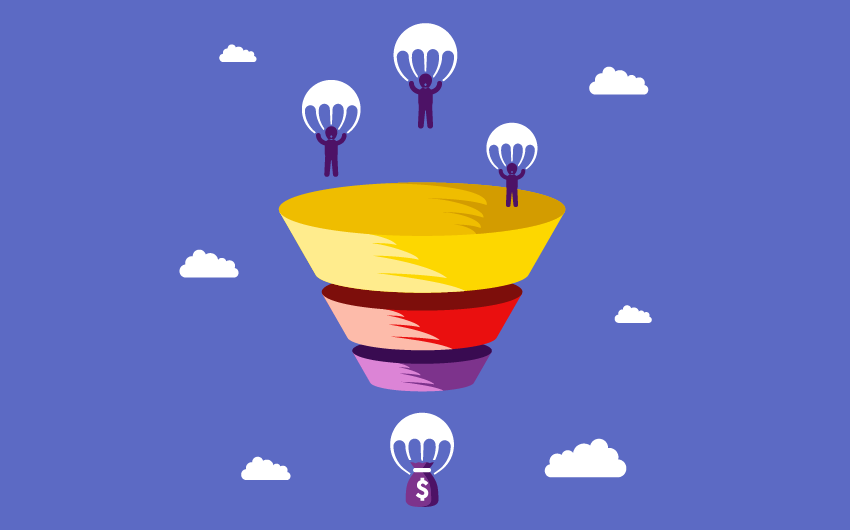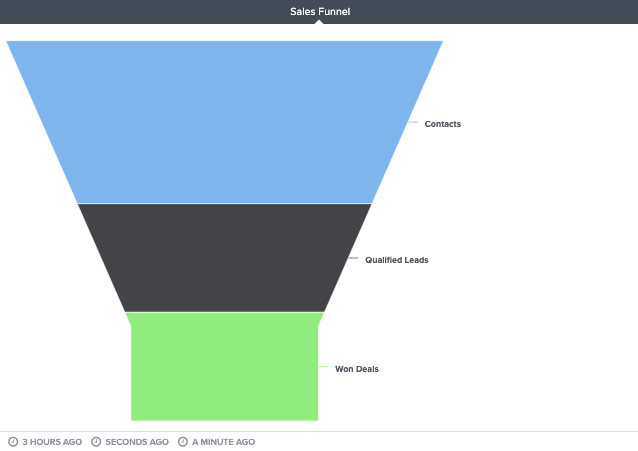Why You Need to Track Your Sales Funnel KPIs

Keeping track of key performance indicators (KPIs) in your sales process is a fundamental part of measuring and improving it. One crucial concept in the sales process is the sales funnel, which divides your customers into different sections of the funnel as they move along your sales process.
- The Top of the Funnel. This is where most potential customers start as new sales leads. In graphics, the top of the funnel is the widest section, as it likely has the most people in it.
- The Middle of the Funnel. The middle of the funnel is reserved for leads who have moved part of the way through your sales process. The criteria for moving a lead into the middle of the funnel may vary depending on your company’s sales process.
- The Bottom of the Funnel. This is the part of the sales funnel where your most qualified leads and those who are about to close a deal reside. The bottom of the funnel is where many sales teams focus their efforts, as it represents their best opportunities for deals.
Why is it called the sales funnel? Because, as prospective leads move through the funnel, there is a tendency for some of them to drop out of your sales process. So, when represented with a picture, the funnel tends to go from being wide at the top to being narrow at the bottom.
Tracking your sales funnel KPIs is critical for evaluating the overall health of your sales pipeline and addressing potential issues. What are some sales funnel metrics you should be tracking, and why are they important? Here’s a short list:
Sales funnel KPI #1: Lead generation
It’s hard to build a healthy sales funnel if you don’t have any leads to track. So, lead generation is a critical sales funnel metric to track. In a nutshell, lead generation is a measure of the number of people you have added to your sales pipeline over a given period of time.

When tracking lead generation as a sales funnel KPI, it can help to track related metrics as well, such as:
- Cold calling activity metrics
- Website form fills (which helps generate leads)
- Social media activity metrics
Activities such as cold calling and social media can help create leads—though their use and the specific metrics you track may vary depending on your sales process. Tracking website activity and which forms your potential customers are filling out (and which ones they’re abandoning partway through) can help you optimize your website and forms to improve lead generation.
Sales funnel KPI #2: Lead attrition
Attrition is a fact of life for any sales funnel no matter how good your sales processes and team are. There are many reasons why a lead may leave your sales funnel, such as the lead realizing they signed up for the wrong type of product/service, to them closing with another company faster, to their circumstances changing so they no longer need anything.
Keeping track of lead attrition at different levels of the sales funnel can help you identify potential issues in your sales process. For example, if 90% of your new leads never make it to the middle of the funnel, that’s a good indication that you may need to refine your lead generation methods. Why? Because that many people dropping out of the funnel right after entering may indicate that they weren’t a good fit for your product or service.
By measuring lead attrition, you can identify steps in your sales process that are proving problematic. From there, you can make refinements that will, hopefully, help reduce attrition.
Sales funnel KPI #3: Time to conversion
How long do customers spend in each section of your sales funnel? Time to conversion is an important sales funnel metric to track alongside lead attrition because it can help highlight a cause for attrition.
For example, say that one of your steps in the sales funnel, such as from the middle of the funnel to the bottom of the funnel, has an extremely high lead attrition rate and a long time to conversion for the few customers that do make the transition. The long wait to convert could be causing leads to lose interest in your product or service.
Finding ways to speed up the transition from middle of the funnel to bottom of the funnel could help your sales team keep potential customers interested. This can involve any number of measures depending on how your current sales process is structured. Some common ideas include streamlining your sales process to eliminate blockages in the sales pipeline, adding more sales team members to increase your lead outreach, or using automation to improve communication with your potential customers.
Sales funnel KPI #4: Sales activity metrics
How engaged is the sales team in trying to move customers along the sales funnel—especially those who are in (or ready to transition to) the bottom of the funnel? Sales activity metrics, such as number of phone calls made, emails sent, and time spent engaging with leads can be crucial for measuring the performance of the sales team and determining what is or isn’t working.
If you look at your highest-performing sales team members, what do you see? Are your top performers spending more time on the phone, sending more emails, or arranging demos of your product/service? When you can correlate high-performing salespeople to their most frequent activities, you have a better idea of what will work for the rest of your salespeople. You can also contrast these sales KPIs against those of the lowest performers. What are the least successful members of the team doing that others aren’t?
While not every employee will have the same level of success with the same activities (for example, one sales team member might be really good on the phone while another one is better at writing emails or creating presentations), it can help you optimize your future sales training efforts.
Sales funnel KPI #5: Customer lifetime value
What is the average return on investment you can expect from a customer over their lifetime? Knowing how much a customer will be worth during their time with your company is important for assessing how much you can afford to spend on trying to acquire that customer. As such, customer lifetime value is a crucial sales KPI to know (alongside your cost-per-lead).
Being able to assess the lifetime value of your customers and balancing that against your cost-per-lead and customer conversion rate helps you gauge the success of your sales process. If the average lifetime value of your customers is less than the cost of getting that customer in the door, then something obviously needs to change.
These are just a handful of the sales funnel metrics that you can (and should) track. Do you need help measuring your sales funnel KPIs? Talk to our team to learn more about how you can use data analytics to optimize your sales process!
Free MSA Template
Whether you’re planning your first managed services agreement, or you’re ready to overhaul your existing version, we've got you covered!



